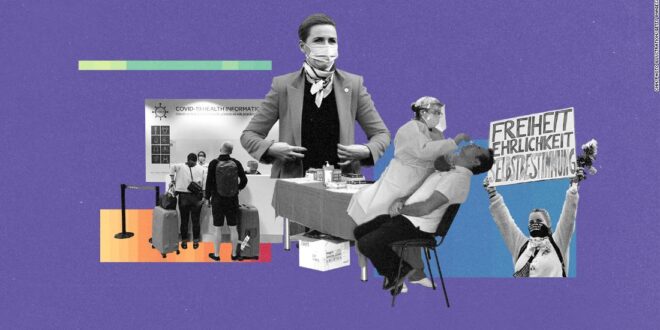Politicians are determined to discover a stability of restrictions that flatten the curve with out flattening the economic system or upsetting residents who’re wanting to reunite for the vacations.
“The important thing query now’s to find out what’s the optimum bundle of insurance policies to maximise the well being profit a minimum of value,” stated Thomas Hale, an affiliate professor of public coverage on the College of Oxford. “Nevertheless, this ‘magic formulation’ will possible differ throughout completely different nations and populations, and naturally over time because the virus surges or recedes.”
It is a sophisticated and ever-changing calculus, and each nation is completely different.
However the approaches of three nations — Finland, Norway and Denmark — in current months stand out, a CNN evaluation exhibits. The evaluation, which checked out knowledge from the College of Oxford and Johns Hopkins College, discovered that whereas all three nations applied a number of the continent’s most relaxed combos of restrictions, they nonetheless managed to maintain common each day deaths low — beneath one per million — for the three-month interval between September 1 and November 30.
Denmark success could also be ending. In late November, Danish dying charges exceeded one per million for the primary time since Could, Johns Hopkins knowledge exhibits. On Friday, the variety of newly reported instances topped four,000. Earlier within the week, officers expanded restrictions and introduced a nationwide lockdown geared toward tamping down rising infections.
However what led to the three nations’ success within the fall?
Denmark, Finland and Norway responded shortly to the slightest improve in infections, which allowed them to nearly eradicate the virus throughout the summer time and face the autumn from a stronger place, in accordance with interviews with six students. Clear steerage and residents’ willingness to comply with it was additionally key, the consultants stated. And ramping up testing and contact-tracing capacities and offering paid sick depart helped to maintain any outbreaks localized.
Tips on how to be the very best (or tips on how to be Finland)
Finland had Europe’s lowest common of infections and deaths per capita in current months, Johns Hopkins knowledge exhibits. It managed to include native outbreaks whereas sticking to a number of the most relaxed restrictions on the continent. Inside motion was not restricted, those that wanted to might attend college and workplaces in individual, and mask-wearing was not obligatory.
“There’s nothing magical about doing this — we simply have a practical method,” stated Pekka Nuorti, an epidemiology professor at Tampere College who has labored for public well being businesses for greater than 25 years.
Cultural, political and geographic elements — resembling low inhabitants density, much less journey and excessive belief in authorities — had been useful, Nuorti stated, nevertheless it was the work of the nation’s well being businesses that made a distinction.
Through the summer time, Finland constructed up “tried-and-true area epidemiology practices,” Nuorti stated: Testing, isolating, contact tracing, quarantining and stopping superspreading occasions on a neighborhood stage.
The common each day testing quantity almost quadrupled from 2,900 samples in Could to 11,300 in August, well being ministry knowledge exhibits. In late November, Finnish laboratories carried out as much as 23,000 exams a day, or 90% of the present capability.
Finland used the summer time to arrange for the brand new wave by responding with preventative measures as an alternative of a lockdown, stated Mika Salminen, director of well being safety on the Finnish Institute for Well being and Welfare. Proscribing worldwide journey for a lot of the summer time added to Finland’s success within the fall, he stated.
To assist folks isolate and keep dwelling, the federal government supplied financial assist. 1000’s of people that had been uncovered might quarantine as a result of the federal government provided compensation for his or her misplaced earnings, Salminen stated.
“It is not that we have not had outbreaks,” Nuorti stated. Finland had native flare-ups and tremendous spreader occasions, however native well being authorities, coordinated by the central authorities, had been capable of include them utilizing real-time knowledge, he stated. However as case numbers rise, it turns into more and more troublesome to determine all transmission sources, Nuorti stated.
If the state of affairs deteriorates, Salminen stated, a full lockdown has not been dominated out.
The Norway manner
Throughout the border, Norwegian officers elevated their concentrate on addressing essentially the most weak.
Norway’s spring lockdown was the strictest in Scandinavia. The nation’s oil and gasoline trade was capable of present a big financial buffer to melt the impact on folks’s purses, however the authorities quickly confronted a rising psychological well being disaster and officers shifted relaxed their restrictions.
Understanding what to do, doing what you are advised
Three consultants interviewed by CNN stated a important think about Denmark’s early success was clear and coherent messaging about dangers and the necessity for behavioral modifications. They attributed the nation’s achievement to its historical past of mutual belief between residents and the federal government.
Petersen stated two elements decide whether or not folks behave to keep away from an infection. One is motivation: Whether or not they’re frightened about changing into contaminated. The opposite is whether or not they know precisely what to do to stop spreading the illness, which hinges on communication from well being authorities and politicians, Petersen stated.
One of many officers main the Danish pandemic response echoed that time.
“Dealing with a pandemic is all about human habits,” stated Søren Brostrøm, basic director of the Danish Well being Authority.
Human habits helps ailments unfold, and controlling it’s the place options lie, Brostrøm stated. Bodily distancing, not a drug or vaccine, is the “medical magic bullet” everyone seems to be hoping for, he stated.
Brostøm spoke to CNN previous to Denmark’s current surge in instances. However at a press convention on Wednesday, Prime Minister Mette Frederiksen addressed the nation’s worsening state of affairs.
“In the long run, just one factor works towards corona,” Frederiksen stated. “That’s if you happen to and I and all of us take accountability for ourselves and for one another.”
Calibrating the restrictions
However as pandemic fatigue seeps in, folks turn into extra reluctant to comply with strict new measures, consultants advised CNN.
Fixed social distancing isn’t sustainable in the long term, Brostrøm stated. A rustic wants simply sufficient restrictions to have the ability to management the pandemic.
“I believe we discovered we truly struck fairly an excellent stability on this nation on this regard,” he stated.
Even in Denmark, one misstep can have a detrimental impact on belief after which compliance, consultants stated.
However the authorities’s overreach shook Danish unity, Petersen stated.
“Proper now, we’re seeing an elevated polarization. We’re seeing decreased assist of the federal government technique. And the query that’s dealing with us right here in Denmark is, ‘What would be the penalties of that for the pandemic over the subsequent months?'” Petersen stated.
Guidelines vs. suggestions
Danish officers’ willingness to impose stricter measures when essential stands in distinction to Sweden, the place officers first took a lighter hand to attempt to stem the pandemic.
“There was a larger emphasis on voluntary measures, and with out the intense ‘shutdown’ measures put in place in Denmark (within the spring),” stated Rowland Kao, a veterinary epidemiology professor on the College of Edinburgh.
“Different Nordic nations are far more consistent with the remainder of Europe,” Kao stated. “That they had a stricter lockdown in spring and did it sooner.”
Kao stated this method made Sweden’s uptick of instances in June, when most different European nations had been recovering, inevitable. And in November, regardless of having a better common stringency rating than different Scandinavian nations, Sweden was struck by a nationwide outbreak.
“When Covid-19 arrived in our nation, all of us agreed to take accountability,” Löfven stated. “This autumn, too many people have uncared for to comply with the recommendation and proposals.”
With regards to a illness that spreads so quick, Kao, the Edinburgh professor, stated very small variations in how issues are accomplished could make all of the distinction on this planet.
How CNN reported this story
For this story, we sought to look at the connection between authorities restrictions and Covid-19 deaths throughout the interval between September 1 and November 30, when many nations had been within the throes of a resurgence.
To take action, we analyzed knowledge from Johns Hopkins College to calculate the each day new deaths per million residents in 31 European nations. We used a shifting common to account for variations within the knowledge induced, for instance, by delays in reporting on weekends, or modifications in knowledge assortment strategies that may in any other case lead to a sudden spike in each day figures. We used new deaths as an alternative of recent instances as a result of the reporting standards for deaths is extra constant throughout nations than for instances, which is partly a operate of testing quantity.
We then plotted the brand new dying charges towards every nation’s stringency rating, which we discovered utilizing Oxford College’s Stringency Index. The index scores nations’ Covid-19 response measures on a scale of 1 to 100.
We analyzed the 27 European Union members, the UK and free commerce nations (Iceland, Liechtenstein, Norway and Switzerland). We excluded Liechtenstein as a result of stringency scores for that nation weren’t obtainable.
Following interviews with consultants, we outlined nations with low an infection charges as these with one or fewer dying per million residents. We outlined much less restrictive nations as these with stringency scores beneath 60 as a result of it was roughly the minimal rating for nations with full lockdowns in October and November in accordance with knowledge we compiled on European nations’ lockdown standing at the moment.
We targeted on Finland, Norway and Denmark as a result of these had been the one nations to persistently keep low dying charges (one per million or much less) and stringency scores beneath 60 throughout the September 1 to November 30 interval. Different nations additionally maintained low dying charges, however we didn’t concentrate on them as a result of they both applied a strict lockdown (Eire) or had a excessive stringency rating (Cyprus).
Antonia Mortensen, Samantha Tapfumaneyi, Nina Avramova, Sharon Braithwaite and Amy Cassidy contributed to this story.
 Top Naija News – Nigeria News, Nigerian News & Top Stories Top Naija News – Nigerian Newspapers, Nigerian News. topnaijanews is a daily Nigerian newspaper covering Latest News, Breaking News, Entertainment, Sports, Lifestyle and Politics.
Top Naija News – Nigeria News, Nigerian News & Top Stories Top Naija News – Nigerian Newspapers, Nigerian News. topnaijanews is a daily Nigerian newspaper covering Latest News, Breaking News, Entertainment, Sports, Lifestyle and Politics.




